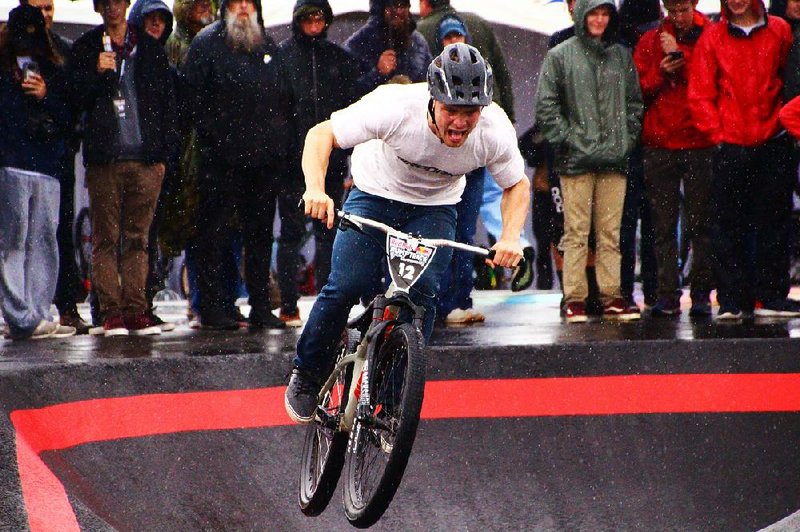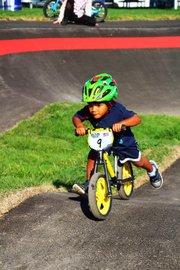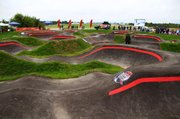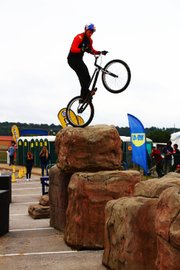Bicyclists from across the country and around the world once again converged on Northwest Arkansas, but not for the famous mountain bike trails or the Joe Martin Stage Race.
They came to Springdale from around the globe Oct. 10-13 to compete in The Jones Center's new Runway Bike Park for the title "The Red Bull Pump Track World Champion."
The action began Oct. 10 with an always entertaining Kids Strider Pump Track Race.
A Strider is basically a small bicycle without pedals, short enough that a child's feet can touch the ground. Any child that can walk can ride a Strider bike, and walking while seated is how they begin learning to ride. As kids become more comfortable walking, they progress to short stretches of lifting their feet to coast; and soon after they are happily gliding about.
The first vehicle of this type, made of wood and built in 1817, was called a "dandy horse."
Strider Sports International founder Ryan McFarland traveled from South Dakota to provide his Strider Balance Bikes for the kids to race. The competition consisted of two divisions, ages 3 and 4, riding Striders with 12-inch wheels, and ages 5 and 6 riding 14-inch Striders.
As did the pros, they competed on a paved loop. The kiddie loop included 25-foot straightaways with short rollers and a sweeping, banked turn on each end. Cute 3- and 4-year-olds stole this show.
Not fully grasping the concept of rules, several stopped and laid their bikes down on the track whenever they wanted, or decided not to ride in the same direction as everyone else.
A couple of youthful cyclists had not discovered that they could lift their feet to coast downhill, rather than fighting gravity with an awkwardly jarring, bouncing trot.
The first official winner of a competition on The Runway Pump Track was a very determined Jesse McCourt, son of Joel and Erika McCourt of Fayetteville.
LAST CHANCE QUALIFIER
Oct. 12 provided an opportunity for area cyclists to compete in the Last Chance Qualifier. This race was open to everyone; and locals were able to square off against the fastest racers in the world.
The big story at the qualifier was Barry Nobles, world-class BMX and mountain bike racer. Nobles had not signed up for the championship event because he was scheduled to race mountain bikes in Canada. But he crashed out early in that competition, and then hearing about the Last Chance Qualifier, decided to come on down.
Although pump track racing is not his specialty, Nobles won the last chance to advance to the finals.
In the elimination rounds Oct. 13, he was one race away from competing for the title. While leading his final heat, he drifted high in the next to last turn, entering a 6-inch "no-man's zone" between the painted upper safety line and open nothingness. It cost him just enough time to lose the race by half a wheel.
He won a consolation race to finish third overall.
TIME TO PLAY
The big day had arrived and with it, a scene: Red Bull's huge winged tent was assembled on one side of the track, and an even larger VIP tent served drinks and food behind the track. Spectator tents lined the grassy, earthen bank bordering the track; and food and merchandise vendors set up in the parking lot. The DJ permeated the air with high energy pulsating beats, and the animated announcer kept the crowd involved in the action.
With an open track and more than an hour before the start of racing, I could not resist trying out the pump track. Borrowing a mountain bike from the Lewis and Clark Outfitters tent, donning my helmet, I excitedly rolled down one of the high, banked turns onto the course. I've raced mountain and road bikes, so I had no problem maneuvering; but, when I began picking up the pace, I was amazed what a workout it was — nothing like what I expected after watching racers "coast around the course."
I was constantly pumping the bike up and over one of the many rollers, maneuvering through one tight, high-banked and gnarly turn after another, or powering across short straightaways. After one lap, which probably only lasted a minute, I rolled up a banked turn to finish totally out of breath.
Pump track is different from other forms of bicycling. It's like taking every feature and banked berm in a one-mile downhill mountain bike course and cramming them in a space the size of your backyard. It was definitely fun and I will be back. Talking with several racers, I was confident that after swapping out the knobbies and dropping the seat, my old 26-inch Gary Fisher hardtail would be reborn.
HALFTIME ENTERTAINMENT
The final day of the event began with a demonstration of jaw-dropping skill by one of the world's biggest names in bike trials, Kenny Belaey of Belgium (check out his online videos). With ease, he jumped his bike from a stationary position straight up to land on a platform six feet off the ground, or bounced up a series of 4-foot rock boulders to pirouette on his rear wheel some 10 feet above the ground. The guy defies gravity.
Later in the day when the obstacles were wet from a light rain, he performed again. Rubber tires on wet painted surfaces and slick rock, not a good combination.
THE MAIN EVENT
The rules for the championship series were simple. There are two categories, men and women, and you "run what you brung." There are those who chose to race on a mountain bike, believing, with the steepest and highest banked turns of any course in the world, the track would favor the larger, 26-inch wheels. Others preferred BMX-style bikes, reasoning the smaller, 20-inch wheels would provide faster acceleration at the start of the race and exit tight turns faster.
After the women's and men's fields had been reduced to 26 and 41, respectively, by using solo timed runs against the clock, all that remained were exciting knockout heat finals: two competitors, head-to-head elimination races — last woman and man remaining crowned the winners.
I had read that the Runway is the largest pump track course in North America, but you have to see it in person to appreciate the size. It was like they took two symmetrical courses and joined them.
At the start of each elimination heat, two racers lined up facing in opposite directions in the middle of the course where the start/finish line was drawn — metaphorically where the two symmetrical courses would have met. With the firing of the starter pistol, riders started their bikes down a short drop and immediately careered into the first sweeping turn.
Accelerating hard over a roller when exiting the turn, their efforts often lifting their front wheels off the track in a wheelie, they raced down a short straightaway over a series of totally rad rollers, to then turbo in and out of the second turn. Immediately exiting this second turn, racers corkscrewed through a tight S-turn before diving, literally airborne, into a final whiplashing turn and then hammering all-out to reach the first of two crossings of the finish line.
They then repeated the maneuvers at max speeds through a duplicate series of turns and rollers on the opposite half of the course.
When racers crossed paths as they powered across the start/finish line halfway through the race, like medieval jousting knights, it was easy to see who was winning — for spectators and racers alike. As a spectator, I followed the trailing riders during the second half of the race, knowing they would push themselves even harder to make up for the deficit and avoid elimination.
Pump track racing is a spectator friendly sport. With the announcer providing running commentary, the DJ blasting out tunes between races and spectators situated so close to the competitors, it makes for an exciting event.
At the end of the day, after a year of competitions and surviving the series of head-to-head elimination finals at the Runway Bike Park, Swiss riders Christa Von Niederhaeusern and David Graf, both riding smaller BMX-style bikes, walked away with the $6,000 first-place prize and the coveted title "Red Bull Pump Track World Champion."
WHAT NEXT?
Although pump tracks have been around for decades — first as small, homemade courses in kids' backyards and then as larger, sophisticated constructions — the Red Bull series has raised pump track competition to a new level, and as a result the sport is growing exponentially.
So grab your bicycle off the hook in the garage, air up the tires, and head to The Runway Bike Park to give it a go. Or, if you live in the Arkansas River Valley, visit the new pump track at Harry Kelley Park in downtown Fort Smith, which was also built by Velosolution. It's a sport the entire family can enjoy together.
Bob Robinson is the author of Bicycling Guide to the Mississippi River Trail, Bicycling Guide to Route 66 and Bicycling Guide to the Lake Michigan Trail (spiritscreek.com).
Style on 10/29/2018



